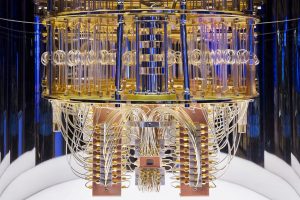
A team of computer researchers with Microsoft and quantum computer developer Quantinuum have managed to configure one of the company’s computers in a way that eliminates the vast majority of errors in the data processed by the as of yet notoriously unstable machines. This is achieved by using an arrangement of the computer’s qubits that allowed the entangled switches to back one-another up when one of them stumbles out of its fragile quantum state.
One of the biggest barriers to a widespread adoption of quantum computers as a commercially viable computing platform is the inherent instability of the mechanism’s qubits—analogous to the single-switch bits that power regular computers— which rely on maintaining their fragile quantum state. Currently, to help maintain quantum stability, the cores of quantum computers are housed in enclosures that shield the qubits from outside radiation, along with a bulky apparatus that cools them to within a fraction of a degree of absolute zero.
But these extreme measures aren’t quite enough to ensure that their qubits maintain their quantum states, allowing errors to drop into the data being processed, a corruption of the information referred to as “noise” by computer engineers.
One way around eliminating errors in computing is to run the same data through multiple units, an error-correcting technique that allows each entangled qubit in a given group, called a “logical qubit”, to store the same information in different places, preserving the data even if one of the individual qubits fails during the process.
Using the 32 qubits available on Quantinuum’s H2 quantum computer, a team of researchers from Microsoft and Quantinuum entangled groups of seven qubits to form a set of logical qubits; using these groups they ran 38,000 experiments and found that, with the close backup that each of the individual qubits provided one-another, yielded a virtual circuit that was 800 times more reliable than using the qubits as individual units.
“These results signify an important transition from noisy intermediate scale quantum computing to reliable quantum computing, and demonstrate advanced capabilities toward large-scale fault-tolerant quantum computing,” according to the team’s paper, published in the journal arXiv.
Although this experiment only involved a handful of logical qubits, the team hopes that this method of error correcting will allow future assemblies of 100 logical units reliable enough to be comparable to classical computers, of which typically only suffer an error rate of only one in 1 quintillion operations (that’s one billion billion, or 1 with 18 zeros).
Subscribers, to watch the subscriber version of the video, first log in then click on Dreamland Subscriber-Only Video Podcast link.